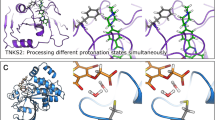Abstract
One of the goals of protein engineering is to design mutants with improved biological profiles, i.e., broader specificity and elevated catalytic activity. Here, we propose a novel, fast and general protocol, based on new GRID/BIOCUBE4mf descriptors, to rank mutants for their ability to affect the pattern of interaction with the ligand, and thus their biological profile. The efficacy of the strategy is proven by establishing relationships between a new descriptor (SumΔn%) and Michaelis constants (K M) for a series of pentalenene synthase mutants.



Similar content being viewed by others
References
Atilgan AR, Durell SR, Jernigan RL, Demirel MC, Keskin O (2001) Anisotropy of fluctuation dynamics of proteins with an elastic network model. Biophys J 80:505–515
Braiuca P, Cruciani G, Ebert C, Gardossi L, Linda P (2004) An innovative application of the “flexible” GRID/PCA computational method: study of differences in selectivity between PGAs from Escherichia coli and a Providentia rettgeri mutant. Biotechnol Prog 20:1025–1031
Caron G, Nurisso A, Ermondi G (2009) How to extend the use of grid-based interaction energy maps from chemistry to biotopics. ChemMedChem 4:29–36
Chiappori F, D’Ursi P, Merelli M, Milanesi L, Rovida E (2009) In silico saturation mutagenesis and docking screening for the analysis of protein-ligand interaction: the Endothelial Protein C Receptor case study. MC Bioinform 10(Suppl 12):S3. doi:10.1186/1471-2105-10-S12-S3
Dunbrack RL Jr (2002) Rotamer libraries in the 21st century. Curr Opin Struct Biol 12:431–440
Eyal E, Najmanovich R, Edelman M, Sobolev V (2003) Protein side-chain rearrangement in regions of point mutations. Proteins 50(2):272–282
Faber HR, Matthews BW (1990) A mutant T4 lysozyme displays five different crystal conformations. Nature 348:263–266
Goodford PJ (1985) A computational procedure for determining energetically favorable binding sites on biological important macromolecules. J Med Chem 28:849–857
Jain AN (2009) Effects of protein conformation in docking: improved pose prediction through protein pocket adaptation. J Comput Aided Mol Des 23:355–374
Lengauer T, Rarey M (1996) Computational methods for biomolecular docking. Curr Opin Struct Biol 6:402–406
Sciabola S, Stanton RV, Mills JE, Flocco MM, Baroni M, Cruciani G, Perruccio F, Mason JS (2010) High-throughput virtual screening of proteins using GRID molecular interaction fields. J Chem Inf Model 50:155–169
Seeback B, Reulecke I, Kaemper A, Rarey M (2008) Modeling of metal interaction geometries for protein-ligand docking. Proteins 71:1237–1254
Seemann M, Zhai G, de Kraker JW, Paschall CM, Christianson DW, Cane DE (2002) Pentalenene synthase. Analysis of active site residues by site-directed mutagenesis. J Am Chem Soc 124:7681–7689
Soss M (2003) Rotamer exploration and prediction. http://www.chemcomp.com/journal/rotexpl.htm
Spyrakis F, Amadasi A, Fornabaio M, Abraham DJ, Mozzarelli A, Kellogg GE, Cozzini P (2007) The consequences of scoring docked ligand conformations using free energy correlations. Eur J Med Chem 42(7):921–933
Vasquez M (1996) Modeling sidechain conformation. Curr Opin Struct Biol 6:217–221
Wade RC, Goodford PJ (1993) Further development of hydrogen bond functions for use in determining energetically favorable binding sites on molecules of known structure. 2. Ligand probe groups with the ability to form more than two hydrogen bonds. J Med Chem 36:148–156
Wade RC, Clark KJ, Goodford PJ (1993) Further development of hydrogen bond functions for use in determining energetically favorable binding sites on molecules of known structure. 1. Ligand probe groups with the ability to form two hydrogen bonds. J Med Chem 36:140–147
Zhang Y (2008) Progress and challenges in protein structure prediction. Curr Opin Struct Biol 18:342–348
Author information
Authors and Affiliations
Corresponding author
Rights and permissions
About this article
Cite this article
Rosso, C., Ermondi, G. & Caron, G. GRID/BIOCUBE4mf to rank the influence of mutations on biological processes to design ad hoc mutants. Med Chem Res 24, 2612–2620 (2015). https://doi.org/10.1007/s00044-015-1333-9
Received:
Accepted:
Published:
Issue Date:
DOI: https://doi.org/10.1007/s00044-015-1333-9




